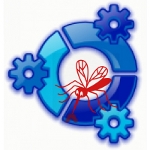Posts Tagged ‘Linux’
 LHS Episode #080: Fitch Best
LHS Episode #080: Fitch Best
 Ever had something you wanted to get off your chest? Richard did on this episode of Linux in the Ham Shack. Somewhere along the line, Russ got sucked in as well and suddenly it was all about stuff the hosts didn’t like. There’s plenty of comic relief in the middle, though, and there is a happy ending when one of the show’s ambassadors calls in to talk about his adventure at a recent hamfest. All in all, a fun ride down Birch Street–uh, you know what we mean.
Ever had something you wanted to get off your chest? Richard did on this episode of Linux in the Ham Shack. Somewhere along the line, Russ got sucked in as well and suddenly it was all about stuff the hosts didn’t like. There’s plenty of comic relief in the middle, though, and there is a happy ending when one of the show’s ambassadors calls in to talk about his adventure at a recent hamfest. All in all, a fun ride down Birch Street–uh, you know what we mean.
73 de The LHS Guys
 LHS Episode #079: Absolutely FABulous
LHS Episode #079: Absolutely FABulous
 Welcome everyone to a very special episode of Linux in the Ham Shack. This week we had the immense pleasure of talking with Fabian “Fab” Scherschel of the Linux Outlaws podcast fame. We tried not to let our man crushes get in the way of the podcast and I think we succeeded for the most part. Fab is a very gracious guest and we had a fantastic time recording the show. When my (K5TUX) Audacity crashed, it was also Fab who came to the rescue and resurrected the show with his backup audio recording. So for lots of reasons, we are indebted to him. We do have to warn you though, our discussion ranges from Debian to software patent issues to pollution in northern New Jersey. It’s a fun journey, but it’s not exactly via the shortest path. Thanks again, Fab. It was a blast.
Welcome everyone to a very special episode of Linux in the Ham Shack. This week we had the immense pleasure of talking with Fabian “Fab” Scherschel of the Linux Outlaws podcast fame. We tried not to let our man crushes get in the way of the podcast and I think we succeeded for the most part. Fab is a very gracious guest and we had a fantastic time recording the show. When my (K5TUX) Audacity crashed, it was also Fab who came to the rescue and resurrected the show with his backup audio recording. So for lots of reasons, we are indebted to him. We do have to warn you though, our discussion ranges from Debian to software patent issues to pollution in northern New Jersey. It’s a fun journey, but it’s not exactly via the shortest path. Thanks again, Fab. It was a blast.
73 de The LHS Guys
 LHS Episode #078: Kubuntu is Bloodthirsty
LHS Episode #078: Kubuntu is Bloodthirsty
 In this episode of Linux in the Ham Shack, our intrepid hosts put aside idle banter, childish meandering and silly stories in favor of true content, both ham radio and Linux related. All right, that doesn’t happen even a little bit. Instead, Richard has a lot of fun telling you all the trouble he has with Linux Mint Debian Edition, all the while mentioning a bunch of other operating systems he’s tried recently including Ubuntu, Kubuntu, Crunchbang among others–letting you know what’s wrong with all of them.
In this episode of Linux in the Ham Shack, our intrepid hosts put aside idle banter, childish meandering and silly stories in favor of true content, both ham radio and Linux related. All right, that doesn’t happen even a little bit. Instead, Richard has a lot of fun telling you all the trouble he has with Linux Mint Debian Edition, all the while mentioning a bunch of other operating systems he’s tried recently including Ubuntu, Kubuntu, Crunchbang among others–letting you know what’s wrong with all of them.
Then there’s some discussion of svxlink, an Echolink client and server application for native Linux environments, Allstar Link, Open Media Vault, contest loggers and a whole bunch of other stuff besides. Ahh, perhaps there is some content here after all. Hope everyone enjoys this episode and can perhaps contribute a dollar or two towards the Hamvention fund. It’s coming up soon and we hope to see you all there.
73 de The LHS Guys
 Ham Radio and Mesh Networks
Ham Radio and Mesh Networks
Lately I’ve been fascinated by the capabilities of mesh networks. The ability to quickly create ad-hock computer networks could be an invaluable resource for amateur radio operators in general and particularly for emergency communications (EMCOM)
The particular device and software I have been experimenting with is the Linksys WRT54G router and HSMM-MESH firmware from http://hsmm-mesh.org/.
Installing the HSMM-MESH firmware changes the way the Linksys router functions and allows it to automatically connect to other HSMM routers in a mesh network. No special configuration is required after setting your callsign. All TCP/IP configuration is pre-configured, even down to automatically assigning addresses to connecting clients.
Mesh networks are highly fault tolerant. Every router in the network is aware of every other router and has the ability to move network packets through from one unit to another provided there is a link, or chain of linked routers, between them.
In the diagram to the right each router is represented by a numbered circle. If router number 6 were to fail then network packets that needed to move between router 1 and 7 would travel through routers 2 & 3 or 5 & 10 until 6 was repaired. All this happens automatically and quickly enough so that there is no disruption to the traffic.
Anything you can access on a normal computer network can be made to work on a mesh network. Some of the services that have been demonstrated include email, voice over IP (VOIP), video conferencing, file sharing, web servers & groupware applications.
 With simple modified antennas the modest output power from the WRT54G (100 to 200mW) can be used to reach distances of many miles or tens of miles with directional antennas. Mounting the router on a mast in a sealed enclosure can reduce losses from long cable runs while running off 12V power makes them compatible with ham radio power sources including solar and wind power.
With simple modified antennas the modest output power from the WRT54G (100 to 200mW) can be used to reach distances of many miles or tens of miles with directional antennas. Mounting the router on a mast in a sealed enclosure can reduce losses from long cable runs while running off 12V power makes them compatible with ham radio power sources including solar and wind power.
The example to the left is from NG5V located on hsmm-mesh.org and consists of an omni-directional external antenna and a lawn sprinkler controller box from a popular home improvement store.
Did you know that … Frequencies used by channels one through six of 802.11b and 802.11g fall within the 2.4 GHz amateur radio band. Licensed amateur radio operators may operate 802.11b/g devices under Part 97 of the FCC Rules and Regulations, allowing increased power output but not commercial content or encryption.
I hope to acquire a few more WRT54G routers and put together a mesh network in the Katy TX area as a resource for experimentation and education in an area not normally touched upon by regular amateur radio operators. Who knows what the future holds & it behooves us to investigate this technology and bend it to our own needs.
The Amateur is Progressive … He keeps his station abreast of science. It is well built and efficient. His operating practice is above reproach.
 Show Notes #077
Show Notes #077
Introduction:
- We’re recording live, with music played as we record. Our guest tonight is Harrison, VE2HKW, from the MintCast podcast.
Announcements:
- The Dalton Hamfest will be in Dalton, Georgia on February 25, 2012. The LHS Ambassador is Ronny, K4RJJ. This has probably come and gone by the time you hear this.
- The KARC Hamfest will be held in Marietta, Georgia, March 17, 2012. Our LHS Ambassador is again Ronny, K4RJJ. Thanks, Ronny!
- The Northeast Linux Fest will be in Worcester, Massachusetts on March 17, 2012. We’re still looking for an LHS ambassador for this event. Contact us at [email protected] if you’d like to help.
- Some of you may have noticed that the LHS web site has been down occasionally. For some reason, the server locks up. We can’t tell if it’s a denial of service attack, or an improper configuration, but we’re working on it.
- Paul, KE5WMA, in the chat room, reminds us of the Acadiana Hamfest on March 9, 2012, near Lafayette, LA., and the New Orleans Hamfest on March 24, 2012.
- Happy Mardi Gras!
Topics:
- Linux Utilities – Russ introduces us to some GNU/Linux utilities that provide information about your Linux system’s performance.
- top shows a list of the processes running in descending order of resource consumption.
- iftop allows you to monitor connections to your machine and the bandwidth used by each.
- ifstat reports the amount of data passing through the interfaces every second, or other interval. For example, ifstat -i eth0 10 1 would report how much data moved through the first ethernet port in 10 seconds, and only do this once. Handy for capturing such information in a script program.
- iotop shows what processes are the top disk I/O users.
- All of these are command line utilities. Press Q to exit. Check the man pages for other keystrokes that can be used while the utilities run.
- Interview with Harrison, VE2HKW
- Harrison, VE2HKW, is a recent ham radio licensee and describes his introduction to the hobby, what he likes and doesn’t like, and provides an overview of the Canadian amateur radio licensing structure.
- Harrison is also a member of the Covey Hill Amateur Radio Club (CHARC).
- Check out Harrison’s blog and pictures of his ham shack.
- Tune in to the MintCast podcast on Monday nights, 8:00pm eastern time, 01:00 UTC. Join the chat at irc.spotchat.org, #mintcast
- You can contact Harrison by email at [email protected] or [email protected].
Feedback:
- We received donations from Steve S., Paul G., and Bill H. Thank you! These donations will be added to the Dayton Hamvention fund to cover the costs of LHS’ presence at the 2012 Dayton Hamvention in Dayton, OH, May 18-20, 2012.
- LHS had several mentions on Twitter by Neptune78.
- Serge, ON4AA, asks about using the LHS logo to publicize the show. Russ explains that the LHS logo is not Creative Commons licensed, so please ask for permission to use it.
- Larry Bushey of the Going Linux podcast responds to recent comments we made about their show. It’s a love fest!
- Leif, KC8RWR, continues an ongoing comment dialog.
Contact Info:
- Contact Richard at [email protected], Russ at [email protected], or both at the same time at [email protected].
- Listen to the live stream every other Tuesday at 8:00pm Central time. Check the LHS web site for dates.
- Leave us a voice mail at 1-909-LHS-SHOW (1-909-547-7469), or record an introduction to the podcast.
- Sign up for the LHS mailing list.
- Sign up for the MAGNetcon mailing list.
- LHS merchandise is available at the Merch link on Web site. Check out the Badgerwear or buy one of the other LHS-branded items at PrintFection.com/lhs or Cafe Press. Thanks!
- Thanks to Dave from Gamma Leonis for the theme music.
Music:
- “Rainbow Over The Bayou” by Regis V. Gronoff, from the album Hummingbird & Honeybee, courtesy of Jamendo
- “Twist and Shout” by Swamp Daddy, from the album Swamp Daddy, also courtesy of Jamendo.
 LHS Episode #077: North of the Border
LHS Episode #077: North of the Border
 Today Linux in the Ham Shack is graced with the appearance of an additional co-host: Harrison, VE2HKW, an amateur radio operator from Canada and sometimes host of the Mintcast, a podcast for Linux users from members of the Linux Mint community.
Today Linux in the Ham Shack is graced with the appearance of an additional co-host: Harrison, VE2HKW, an amateur radio operator from Canada and sometimes host of the Mintcast, a podcast for Linux users from members of the Linux Mint community.
In the first segment, our hosts discuss three very useful Linux utilities for analyzing system performance on your desktop or server: iftop, ifstat and iotop. Get in-depth knowledge of how to use these tools in order to make your machine run better with fewer bottlenecks. And since Harrison is from a whole other country, it was decided he should tell all of us about amateur radio from a Canadian perspective, including licensing, regulations and operating practices.
Hamvention 2012 is coming up very soon. Please donate to the fund if you can. We hope to see everyone there!
73 de The LHS Guys (and Harrison, too)
 Show Notes #076
Show Notes #076
Introduction:
- Only 317 days until the end of the world as we know it!
Announcements:
- The Black Sparrow Media application for iPad, iPhone and iPod has been submitted to the iTunes store. It is just awaiting validation from Apple, which may take up to two weeks. We’ll let everyone know when it’s available.
- Special Event Station W0S (Whiskey Zero Sierra) will be operating from the Titanic Branson Museum from April 13-15, 2012, commemorating the 100th anniversary of the Titanic disaster. Russ, K5TUX, will be operating the station at some point.
Feedback:
- Scott, AD7MI, asks for help linking APRS and his his Davis Vantage Pro2 weather station with Xastir. Our hosts suggest trying one or both of these:
- Meteo – Davis weather station platform software for Linux. You can subscribe to the Meteo mailing list by sending a subscription request to [email protected]. It has been several years since Meteo was updated, and is still not at version 1.0. You must download the .tar file from the web site as it does not appear in the distribution repositories.
- wview- Cross-platform weather station software. It does need an internet connection if you are going to contribute information to various weather sites, such as:
This program is under active development. Even if it requires a work-around to perform as you wish, it may be worth the trouble. If you’ve ever configured a Linksys router, the web interface of wview looks a lot like that. wview has a support site via Google Groups at http://groups.google.com/group/wview.
Let us know how you get on, Scott!
Russ signed up for the AllStarLink network; it’s very similar to joining EchoLink. AllStar uses the Asterisk VOIP system, and Jim, WB6NIL, is the author of the repeater link software. Russ had success using a Mac computer, but not with a Linux machine.
Richard sees the biggest problem with EchoLink is that it only allows one connection per IP address, so you can’t have both a server and client at home. The EchoLink site only sees your IP address assigned by your ISP, which limits you to one connect from home. In this respect, AllStarLink appears to better in that it seems to allow multiple connections.
AllStarLink is available in several combinations of Linux and Asterisk:
- ACID – based on CentOS
- Limey Linux – based on embedded Linux and bootable from a flash drive, and runs ONLY on several specific Mini-ITX motherboards.
- Pickle – a specialized embedded Linux distro designed to operate on a BeagleBoard-xM (and DMK Engineering LOX board).
Russ then provides an overview of setting up an AllStar Link client.
Richard defends the use of “mode” as appropriate as the definition allows it to mean “a method or means of doing something”. For example, CW vs DFCW (dual-frequency CW), where DFCW uses frequency shifts to distinguish dots and dashes, rather than two different lengths of the same frequency, and spaces. Both are CW.
Contact Info:
- Contact Richard at [email protected], Russ at [email protected], or both at the same time at [email protected].
- Listen to the live stream every other Tuesday at 8:00pm Central time. Check the LHS web site for dates.
- Leave us a voice mail at 1-909-LHS-SHOW (1-909-547-7469), or record an introduction to the podcast.
- Sign up for the LHS mailing list.
- Sign up for the MAGNetcon mailing list.
- LHS merchandise is available at the Merch link on Web site. Check out the Badgerwear or buy one of the other LHS-branded items at PrintFection.com/lhs or Cafe Press. Thanks!
- Thanks to Dave from Gamma Leonis for the theme music.
Music:
- To be added.














